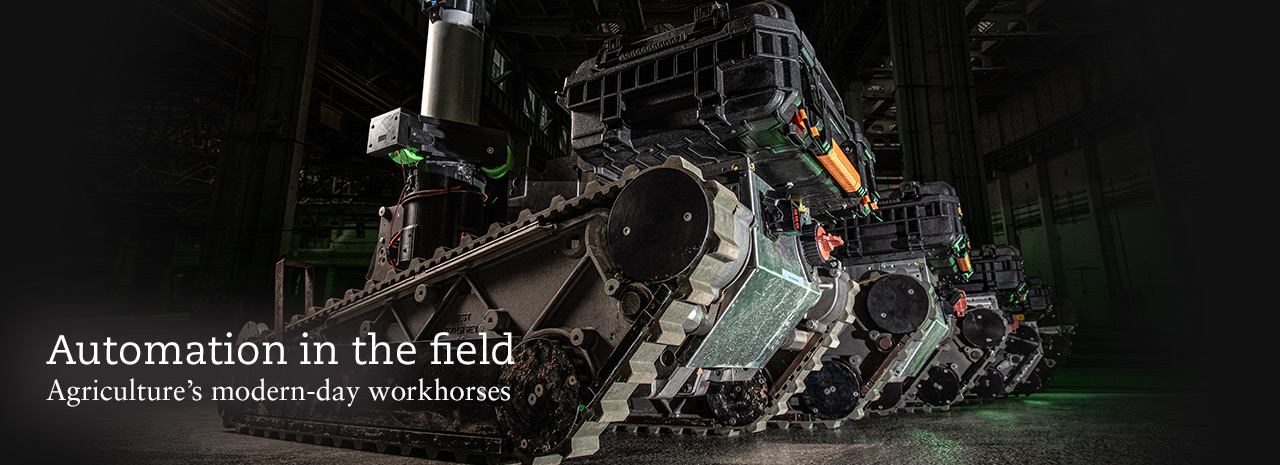Automation in the field: Robots, drones are becoming agriculture’s modern-day workhorses
By Pat Melgares
Watch a video that shows how K-State is developing technology to help farmers.
On a patch of land north of the Kansas State University Manhattan campus, Dan Flippo and four of his engineering students test one of their newest creations: a small robotic tractor designed to dig a trench and plant seeds in unison.
The machine, which measures about 2 feet tall and 3 feet wide, crawls slowly across the test site under the group’s watchful eyes. The blade intended to cut the trench seems a bit inefficient, and the machine fails to cut the straight path that Flippo had hoped to see.
It turns out to be a great test for the Carl R. Ice College of Engineering students, who will go back to the lab and work out the few hiccups they discovered on this day.
It also offers a glimpse at agriculture of the not-too- distant future, when small machines guided by computer programs may do some of the work and give farmers large volumes of information that they can use to plant, manage and harvest better crops.
“We are not trying to replace or get rid of tractors; we are trying to make more food,” said Flippo, assistant professor of biological and agricultural engineering. “By 2050, we are going to have close to 10 billion people, and right now we are not close to meeting the amount of food production that will be needed.”
Much of agriculture already is touched by some form of technology, whether it be sensors on tractors that
precisely measure planting and fertilizing rates or thermal infrared cameras attached to unmanned aircraft, also known as drones, that y above farm fields and detect water or insect stress in crops. There are even robotic arms that can milk a cow.
“I think farmers are ready for everything that is easy to adopt and that gives them a reliable and con dent source of information,” said Ajay Sharda, associate professor of biological and agricultural engineering. “That’s their bottom line. They cannot spend hours and hours to set it up or hours to run it.”
Therein lies an opportunity for universities like K-State, which in recent years has built considerable momentum toward incorporating technology on America’s farms.
Rovers on the lookout
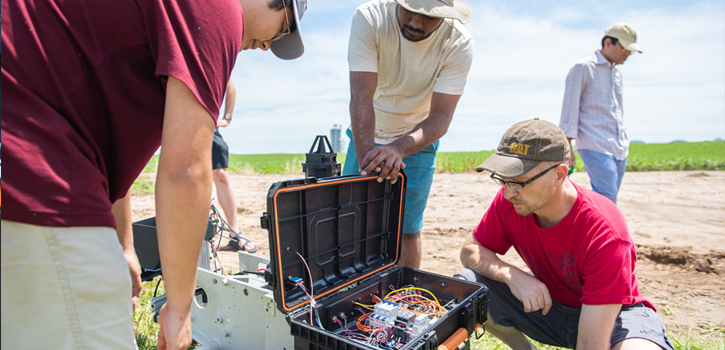
While companies like John Deere and Case IH are leading the way in developing autonomous, or self- driving, tractors, Flippo says universities play a key part in developing smaller vehicles to aid in farm work.
Flippo’s fleet includes several vehicles that spent their first lives as motorized wheelchairs. Flippo and the team of students, which includes undergraduate and graduate students, are using the motors and casing to custom build machines that serve a specific purpose on the farm.
“There are different categories that we are building,” Flippo said. “The first is the rover category. This would be like a microwave-size robot. Their purpose is to go out and scout a field, which is important because while humans can scout really well, nobody wants to walk around a field all day.”
When entomologists go out to look for pests in a field, they may look at two or three spots and make a judgment about the whole field. Rovers can cover the entire field, perhaps even working through the night, and provide data on pests.
“There are some issues, such as if the rover breaks, you’re going to have to go find it in the field,” Flippo said, and noted that engineers also need to account for how long a vehicle can hold a charge, how it handles ruts in the field and if it can follow the correct path between rows.
“But these small rovers can go through the field consistently and keep track of the field much better than humans ever could,” he said.
Flippo’s team is building a second category of ground robots that is slightly bigger than the rovers. They are called ag drones, and Flippo refers to them as “the workhorses.” Ag drones can be used to carry chemical tanks to an area of a field or to plant seed in areas, such as sloped hills, where a larger tractor can’t go safely.
Larger robots, some the size of lawn mowers and others the size of bed frames, are capable of more conventional farming work, such as pulling disc drills for wheat, scouting fields and planting fields. K-State is not yet working on these types of robots, Flippo said, but he noted that as the robots get bigger, companies and farmers become more concerned about safety.
Insect detection
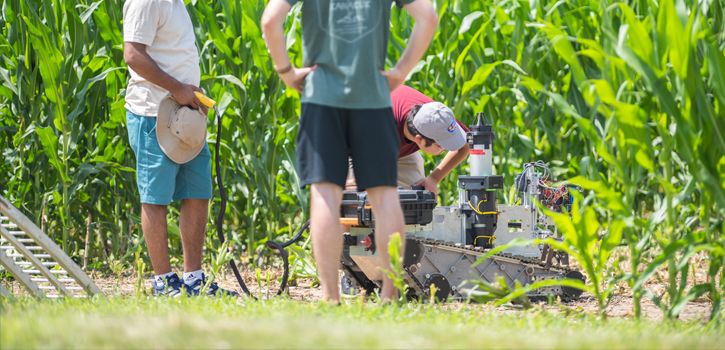
Flippo, Sharda and Brian McCornack, professor of entomology in the College of Agriculture, recently received a nearly $883,000 grant from the U.S. Department of Agriculture through its National Robotics Initiative to study the use of robots that detect and defeat insects in crop fields.
The nation’s farmers spray nearly $15 billion worth of chemicals annually, yet still lose 37 percent of their crop yields to pest damage, according to the USDA.
The K-State group is working on a rover with a sensor on the front of the vehicle to detect insects, such as aphids, in a sorghum field. The sensor can detect if the concentration of aphids, which measure one-eighth of an inch or less, exceeds a predetermined critical limit.
When the concentration of insects exceeds the critical limit, the robot sends a signal to a sprayer that is mounted to the back of the vehicle. The sprayer takes that cue and knows immediately that it should treat the area.
“We are going to synchronize the system so that based on the moment that the vehicle sees the insects, it will start spraying backward and build a buffer zone around the area,” Sharda said. “In other words, it will spray beyond the point where the insect was sensed to establish a full zone of control.”
Sharda said spraying from below the crop canopy helps to contain more of the chemical where it’s needed and reduce spray drift. Ultimately, that means less chemicals used and less cost to the farmer.
Eye in the sky
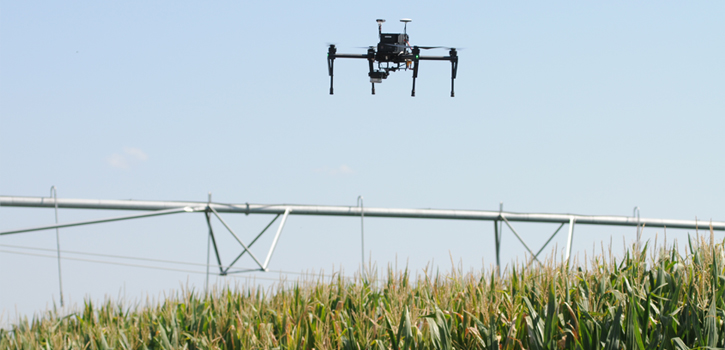
Sharda also is leading a project to use unmanned aircraft, best known as drones, to scout crop fields for water stress. The four-year project is helping farmers schedule irrigation more efficiently because they better understand field areas that are more stressed than others.
The researchers have mounted thermal infrared cameras to the drones, which they fly several hundred feet above the field. The cameras measure canopy temperature throughout the field and send volumes of information to a computer on the ground that formats the data into a model to give the farmer irrigation guidance.
Eventually, Sharda said this system could be combined with information from the ground robots to give farmers an even clearer picture of their crops’ water needs.
K-State also is developing drone technology to detect insect pressure in crop fields.
“In regard to unmanned aerial vehicles, I think farmers are getting more con dent in terms of what they are seeing,” Sharda said. “There is a lot of research being done by universities and lots of companies are spending resources on many acres across the U.S. to make those models more robust. The artificial intelligence capabilities are definitely improving.”
Shrinking workforce
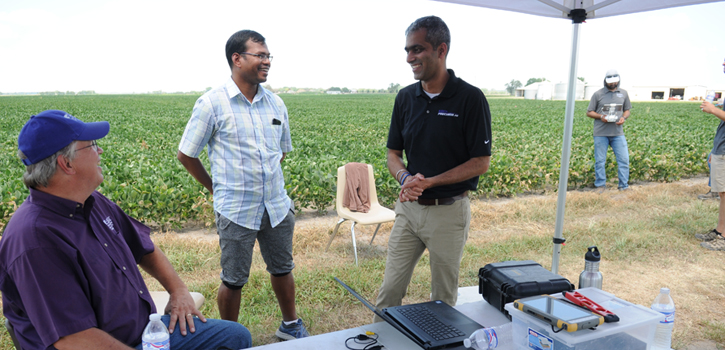
Statistics on farm labor indicate that the industry may need help. A 2013 report by the USDA-funded National Agricultural and Rural Development Policy Center indicates that agriculture is vulnerable to “labor supply shocks, which could increase costs and threaten the ability of some farmers to harvest labor-intensive crops.”
The report also noted that 33% of people employed on farms perform an estimated 60% of the work. The reality for U.S. agriculture is that it may be faced with a shrinking workforce, but newer technology can help.
“We are really good at getting seed in the ground fast, but maybe this is the time to rethink it. What does it really take to get those seeds in the ground?” Flippo said. “Just think if we could have a bunch of small robots going out to do that work. They just go out, cover the entire field and get the work done.”
